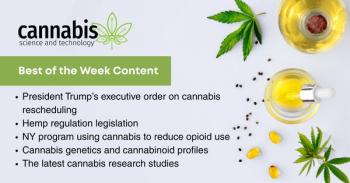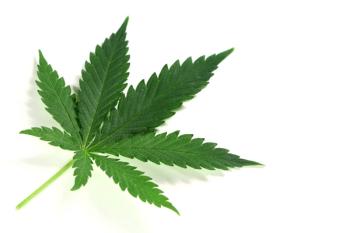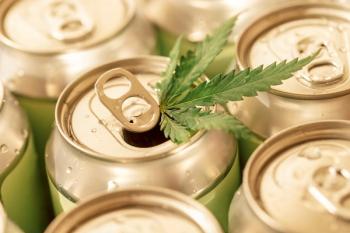
Cannabis Science and Technology
- April 2020
- Volume 3
- Issue 3
How to Distinguish Between Hemp and Cannabis Plants Using Raman Spectroscopy

Dmitry Kurouski discusses the groundbreaking work his team is conducting using a handheld Raman spectrometer to identify cannabis and hemp plants.
Since the passing of the U.S. Farm Bill legalized hemp, the need for a method or testing device to distinguish hemp and cannabis plant material has grown exponentially. From cultivators looking to ensure that their plants are legally hemp or when to harvest to law enforcement looking to make quick roadside decisions regarding legal hemp or cannabis-the ability to accurately identify these plants would be a game changer in the U.S. Dmitry Kurouski, a professor in the Department of Biochemistry and Biophysics at Texas A&M University, recently spoke to us about the groundbreaking work his team is conducting using a handheld Raman spectrometer that can noninvasively and nondestructively identify cannabis and hemp plants.
In your recent article with RSC Advances (1), you presented a noninvasive and nondestructive method to test if plant material is hemp or cannabis. Can you tell us how you were able to achieve 100% discrimination (qualitative) accuracy for this method and if there are any known limitations in the method that you are aware of? Please also tell us what led you to try using Raman spectroscopy (rather than other spectroscopic methods) for this type of detection.
Dmitry Kurouski: That's a great question. The technology that we used to achieve this goal was Raman spectroscopy. In Raman, we shine laser light on a sample, and we collect scattered photons then those scattered photons provide information about the chemical structure and composition of the sample. We collect these photons to measure the energy change between incident light and the photon energy. And these energies tell us about the presence of, for example, carboxyl groups, ketone groups, aldehyde groups as well as saturated and unsaturated bonds.
The biggest difference between hemp and cannabis is the presence of tetrahydrocannabinolic acid (THCA). In hemp, this compound is present in a very low quantity below 0.3%. In cannabis, the percentage varies from 4–12% or even 15% sometimes. Of course, we can see the presence of THCA in our Raman spectra and by measuring the intensity of this band, we can tell what the quantity of THCA is in a given sample. This band is absent in the spectrum of hemp, which is why we can distinguish between hemp and cannabis with 100% accuracy. But in addition to the visible difference in spectrum, we also used chemometrics-advanced statistical analysis-that allowed us to reach a very high accuracy of diagnostics.
Now I should tell you that, in principle, THC diagnostics or differentiation between hemp and cannabis can be done by high performance liquid chromatography (HPLC) analysis. The problem is that HPLC is time and labor consuming. The sample has to be homogenized then an extract of the sample has to be purified and managed, which is in itself pretty time consuming. All of this essentially substantially delays the processing time of material in forensic laboratories.
There was one recent story in the state of Texas where a hemp driver was arrested for being suspected of carrying cannabis. It took one month to finish the analysis. All this time, the person was in jail. The analysis came out negative, but nevertheless, the person had to spend the whole month in jail.
What type of representative sampling methods are required for accurate Raman analysis of a large sample set of the cannabis plant?
Kurouski: There is not any type of sampling required. Any sample can be used. It can be leaves, it can be buds, it can be essentially powder because Raman does not depend on a sample type. It can be solution as well. So, here we can work on all types of samples such as different types of creams, lotions, gels, and any other edible materials that are used as products that contain cannabidiol (CBD) and tetrahydrocannabinol (THC).
How many areas of a plant and how many plants need to be scanned to get an accurate reading for a particular cannabis crop or sample?
Kurouski: With the Raman methodology, only one scan is necessary to be done. It takes 1 second to get this scan done. So pretty much we can shine laser light on any part of the plant material and in 1 second we can tell whether it’s hemp or cannabis with 100% accuracy.
For quantitative analysis, how accurate is this new method in determining the active THC and THCA levels? How does this accuracy compare with the accuracy needs of regulatory agencies or law enforcement?
Kurouski: That's a good question. Currently, the accuracy is within 1%. What does it mean if it's 1%? If the sample has 5% THCA, our instrument can show that it's 4% or 6%. And while you may say, hey, this is not good enough for forensic expertise because it cannot distinguish whether it’s 0.29 or 0.31 which is wrong because here is the reality. The reality is that cannabis typically contains about 4% of THC, from 4–12%. And if the police expert, using our technology directly in the crime scene or on the road scans the sample and gets from 3–5%, the forensic expert knows that this cannot be hemp. It is cannabis. It must be cannabis.
Imagine that 80–90% of all samples that forensic laboratories deal with are cannabis. So, with this technology, we can eliminate 80–90% of samples that are currently received by forensic laboratories. And of course, if this will happen, then the remaining 10% or 15% can be analyzed within hours or days in the forensic laboratory.
If, for example, the plant material sample has 1% THC in our spectrometer its result is inconclusive and it must be sent to a forensic laboratory. But as I said, around 90% of those samples are actually THCA. Our job is to catch this big fish to eliminate 90% of the work for forensic laboratories.
How does this method compare to other testing methods currently in use?
Kurouski: Well, like I said, there are three major methods that I used. One of them is HPLC, it's very robust and reliable, but it requires substantial sample processing and shipment to a forensic laboratory. It's also destructive. Considering processing time that should be multiplied by the amount of money to pay the professional labs, it becomes very expensive for the state to do this.
An alternative to this is the color test, but the problem is the color tests are very unreliable and not very specific, although they are quite popular. But nevertheless, police do not rely on them. And the last method that was currently developed is near infrared spectroscopy (NIR). Although they claim it to be accurate, a huge limitation with NIR is that the sample has to be dried and homogenized to avoid the presence of water because water will eat all IR signal, which is not a problem for Raman.
Therefore, we believe that our technology, because we can work on live green plants, can be useful not only for forensic area or law enforcement, but also to a large extent for plant farmers and growers. Because using our technology, they can measure live plants directly in a greenhouse and find out what the THCA content is of these plants, when to harvest, how to breed, and how to develop new breeds of cannabis. All of this very interesting work can be done using Raman spectroscopy.
Do you believe that this tool will aid hemp producers by allowing them to deliver their products with appropriate levels of THC and THCA more efficiently without being stalled by regulatory or law enforcement personnel-will this provide for an overall increase in production efficiency?
Kurouski: Absolutely. Yes, absolutely. We’ve heard very positive feedback from several cannabis and hemp producers in the state of Colorado, primarily guys we work with together. They're very excited about this tool because they grow hemp and they grow cannabis. They have to ship material to HPLC labs and pay money. Of course, it's not preferred because they damage plants. And if you want to be precise in farming, you have to do it like every three days to find out when is the best time to harvest plants. Can you imagine having a device like the laser pointer to shine on a plant and you know that you have to harvest in two days or 2–5 hours. That will change the logistics of farming.
Of course, this type of farming, which we call digital farming or digital agriculture is the future not only in the area of hemp growing, but also in the area of grain and pretty much any plant growing in the U.S. and abroad.
Are there any other applications that this technology could be used for in the cannabis industry? For example, would it be able to determine terpenes or other cannabinoids?
Kurouski: We’re currently working to understand or to investigate this applicability of Raman specifically right now. My lab works on Raman based identification of CBD, cannabidiolic acid (CBDA), cannabigerol (CBG), and cannabigerolic acid (CBGA), which are four other very important cannabinoids. Cannabinoids that are not making people high and don't have this fear of psychotropic effects, but instead they have very unique pharmacological effects.
For example, CBD reduces chronic pain and anxiety, whereas CBG is a great antibacterial agent and many farmers trust that in growing those plants specifically for production of CBD and CBG. And yes, we have preliminary results that suggest that Raman can distinguish between CBD and THC, CBG and CBGA, and so on.
What are your next steps with this research, and what improvements in handheld instrumentation would you like to see?
Kurouski: Well, the next thing is, of course, to develop it for diagnostics of a large variety of cannabinoids. We are not interested only in THC and THCA. But like I said, CBG, CBD, CBDA, CBGA, and more. There are about 120 different cannabinoids in plants and many of them have very unique properties.
Also, we understand that this technology can be used to check plant identity, which is very important to track the origin of harmful cannabis. Using this technology, we’ve already shown that we can distinguish between different strains or varieties of hemp with about 95% accuracy. Imagine the applicability of this. We can pretty much trace the origin of hemp or cannabis and say “okay, this cannabis came from Mexico, Canada, or from Texas or Colorado.” And lastly, what we are interested in is, of course, pushing down the accuracy of detection to probably 0.1% or even below.
References:
- L. Sanchez, C. Filter, D. Baltensperger, and D. Kurouski, “Confirmatory non-invasive and non-destructive differentiation between hemp and cannabis using a hand-held Raman spectrometer,” RSC Advances 10(6), 3212–3216 (2020).
https://doi.org/10.1039/C9RA08225E .
How to Cite this Article
M. L’Heureux and M. Colli, Cannabis Science and Technology 3(3), 53-54 (2020).
Editor's note: The version of this article that appeared in the April 2020 print issue was an excerpt of the full interview presented here.
Articles in this issue
over 5 years ago
Co-Solvent Ethanol Injection Helping CO2 Extractionover 5 years ago
Beyond Potency: Flavonoids-the Purples, Reds, and Bluesover 5 years ago
The Root of Success: Using the Right Growth SubstrateNewsletter
Unlock the latest breakthroughs in cannabis science—subscribe now to get expert insights, research, and industry updates delivered to your inbox.




